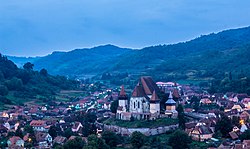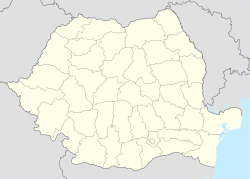Biertan
| Biertan | |
|---|---|
| Commune | |

|
|
 Location of Biertan, Sibiu |
|
| Location of Biertan, Sibiu | |
| Coordinates: 46°8′23″N 24°31′25″E / 46.13972°N 24.52361°ECoordinates: 46°8′23″N 24°31′25″E / 46.13972°N 24.52361°E | |
| Country |
|
| County | Sibiu County |
| Status | Commune |
| Founded | 1224 (first official record) |
| Government | |
| • Mayor | Cornel Rațiu (Social Democratic Party) |
| Area | |
| • Total | 97.26 km2 (37.55 sq mi) |
| Population (2011) | |
| • Total | 2,519 |
| • Density | 26/km2 (70/sq mi) |
| Time zone | EET (UTC+2) |
| • Summer (DST) | EEST (UTC+3) |
| Postal Code | 557045 |
| Website | http://www.comunabiertan.ro |
Biertan (German: Birthälm, Romani: Biyertan, Hungarian: Berethalom) is a commune in central Romania, in the north of the Sibiu County, 80 km north of Sibiu and 29 km east of Mediaş. Biertan is one of the most important Saxon villages with fortified churches in Transylvania, having been on the list of UNESCO World Heritage Sites since 1993. The Biertan fortified church was the see of the Lutheran Evangelical Bishop in Transylvania between 1572 and 1867.
The commune is composed of three villages: Biertan, Copșa Mare (Gross-Kopisch; Nagykapus) and Richiș (Reichesdorf; Riomfalva), each of which has a fortified church.
The first documentary testimony about the village dates from 1283 in a document about the taxes paid by the inhabitants of 7 villages and so it is believed to have been founded sometime between 1224 and 1283 by Transylvanian Saxons. The village settlement quickly developed into an important market town and by 1510 Biertan supported a population of about 5,000 people. Between 1468 and the 16th century a small fortified church (die Kirchenburg) was constructed and developed. After the medieval period the town declined in importance with the rise of neighbouring Sighișoara (= Schäßburg in German), Sibiu (Hermannstadt) and Mediaș (Mediasch).
...
Wikipedia

